Tarps are one of the most versatile pieces of gear a person can have, so it’s no wonder that people are constantly on the lookout for new tarp shelter ideas.
Here are fifteen tarp shelter configurations you can use. Remember that depending on your environment, certain configurations may be more suitable than others.
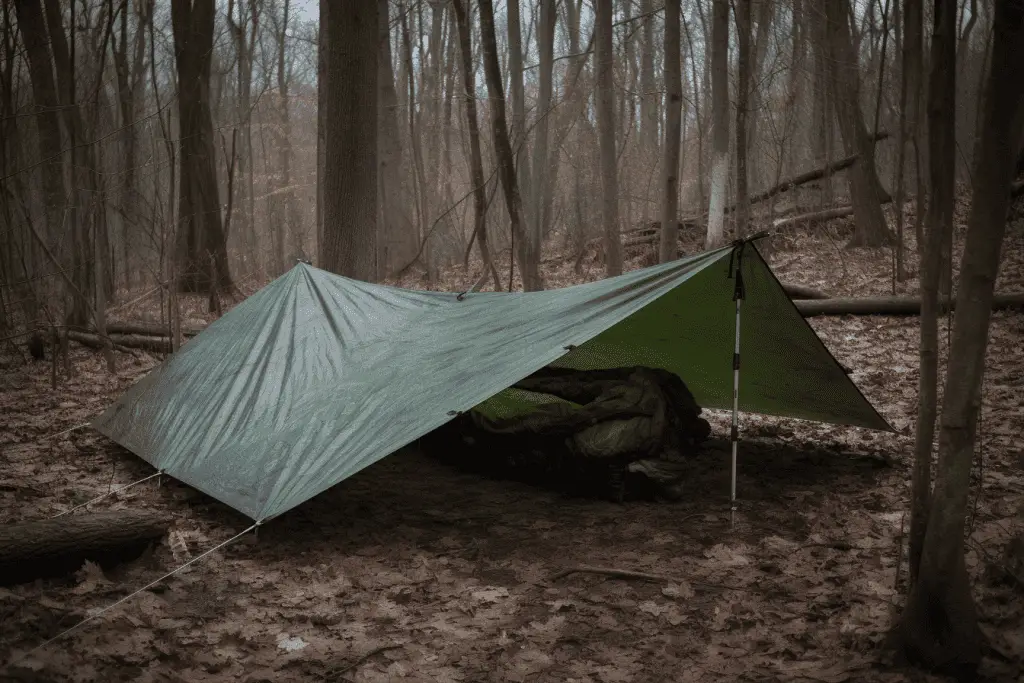
1. A-Frame Shelters
When it comes to tarp shelter ideas, the A-Frame Shelter stands as one of the classics. This design is cherished for its simplicity, yet it’s impressively effective when it comes to providing a haven from the elements. Think of it as the cozy log cabin of the tarp world, a little slice of home that can be erected wherever you lay your pack.
The A-Frame’s primary strength lies in its ability to guard you against overhead elements. Whether you’re dodging downpours, hiding from the midday sun, or seeking refuge from a flurry of snow, the angled design effectively repels these nuisances from above. It’s like carrying an umbrella, but with a sense of stability and permanence that allows for rest and recuperation.
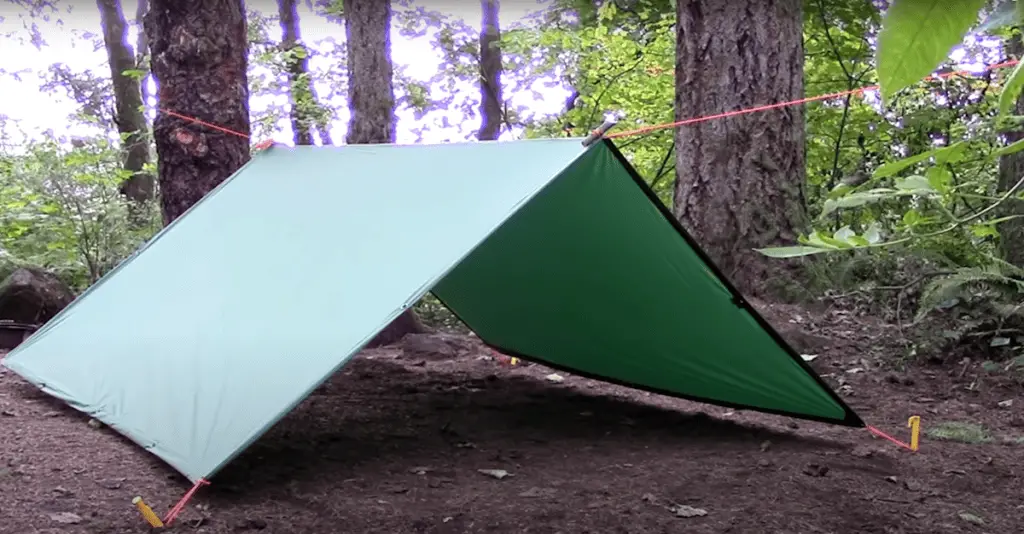
However, every design has its trade-offs, and the A-Frame is no exception. While it stands tall against overhead nuisances, it may struggle in the face of wind and sideways rain. It’s not that the A-Frame can’t handle these elements, but rather that its open-ended design leaves some exposure on the sides. So, if you’re considering tarp shelter ideas for particularly windy conditions, or if sideways rain is a regular occurrence, you might want to explore other options or be ready to adjust your A-Frame setup accordingly.
Here’s a table outlining the pros and cons of an A-frame tarp shelter:
| Pros | Cons |
|---|---|
| Simple to construct | Less effective against wind and sideways rain |
| Provides good protection from overhead elements | Limited protection on the sides |
| Uses minimal equipment (typically just a tarp and some cordage) | The shelter’s stability depends on the strength of the anchor points |
| Can be set up in various terrain types | Can feel cramped if not sized appropriately |
| Great for quick setups | Requires regular adjustment to stay effective in changing weather conditions |
| Ventilation can be easily managed by adjusting the height | Not ideal for multiple people unless a larger tarp is used |
2. Diamond Shelters
Looking to round out your repertoire of tarp shelter ideas? Let’s consider the Diamond Shelter. This design is a backpacker’s dream – compact, efficient, and perfect for a solo adventurer. Whether you’re off on a weekend hike or immersing yourself in nature for a few weeks, the Diamond Shelter offers a reliable retreat from the elements.
What makes the Diamond Shelter stand out? First, it has got your back… quite literally! Its design gives you excellent protection from overhead and rear elements. It’s like having a sturdy shield against rain, snow, or sun that’s coming down from above or creeping up from behind. Add to this the convenience of a quick and straightforward setup, and you’ve got a winning combo.
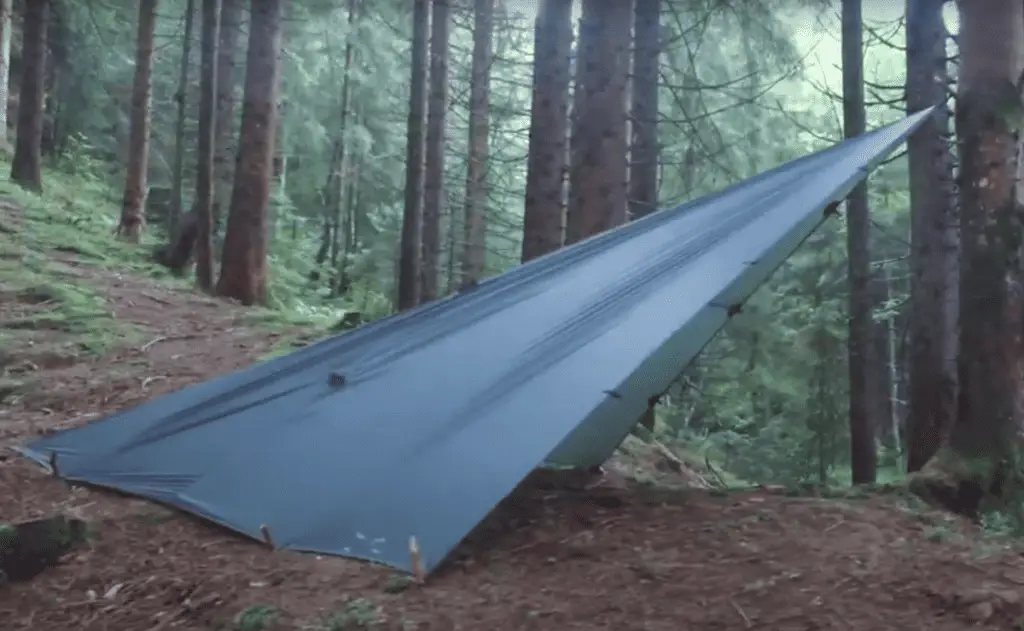
However, like any structure, it’s not without its quirks. The Diamond Shelter features open sides, which offer a fantastic view of your surroundings and a refreshing airflow, but they can also expose you to wind and sideways rain. This means you’ll want to think carefully about where and when to deploy this kind of shelter.
Now, let’s take a look at the Diamond Shelter’s pros and cons.
| Pros | Cons |
|---|---|
| Easy to set up | Limited protection on the sides |
| Great for one person | Not ideal for multiple occupants |
| Provides excellent overhead and rear protection | Less effective against wind and sideways rain |
| Compact and efficient | Choosing the right location is crucial to maximize protection |
| Excellent for quick breaks during hikes | Might require additional windbreaks in windy conditions |
3. Lean-to Tarp Shelter
If simplicity is the name of your game when you’re brainstorming tarp shelter ideas, then the Lean-To Shelter should be at the top of your list. This design is as straightforward as it gets, making it an excellent option for beginners or anyone needing quick shelter on the fly.
The Lean-To Shelter is like your trusty guard, providing protection from wind and rain that’s coming from one direction. This makes it ideal when you’ve got a consistent wind direction or when you can set it up against a natural windbreak like a row of trees or a large rock.
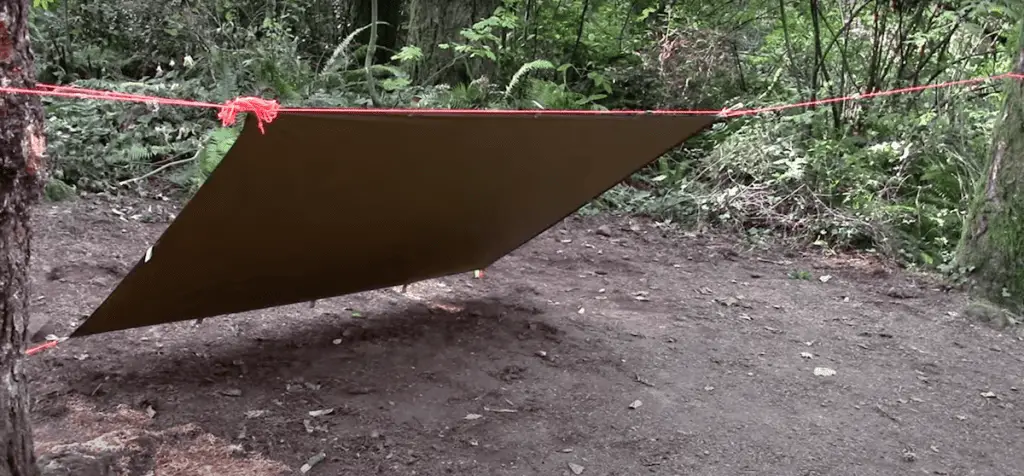
But remember, with a Lean-To Shelter, it’s all about positioning. This design provides excellent protection on one side, leaving the other side open. While this can be great for enjoying a view or a campfire, it also means you’re more exposed to the elements from the open side.
Now let’s put this all into perspective with a handy pros and cons table.
| Pros | Cons |
|---|---|
| Simple and quick to set up | Protection is only from one side |
| Provides good shelter from wind and rain in one direction | Choosing the right direction is crucial |
| Great for enjoying views or a campfire | Not ideal for changing wind directions |
| Requires fewer resources to set up | Less protected in heavy rain or snow |
| Can be set up against natural windbreaks for extra protection | May require additional windbreaks in windy conditions |
4. Flying Diamond Tarp Shelter
As you consider various tarp shelter ideas for your outdoor adventures, let’s fly into the realm of the Flying Diamond Shelter. A cousin of the Diamond Shelter, this variant brings a little extra to the table, providing a bit more wind protection, which can be a game-changer in certain weather conditions.
The Flying Diamond Shelter essentially takes the one-person-friendly design of the Diamond and gives it wings, enhancing its ability to shield against wind. This makes it a fantastic choice for those breezy days in the great outdoors when you want that extra buffer.
While the additional wind protection is a notable perk, it’s essential to remember that the Flying Diamond, like its simpler counterpart, still features open sides. While this offers a refreshing connection with your surroundings, it may also expose you to the elements in certain weather conditions.
To summarize, let’s lay out the pros and cons of a Flying Diamond Shelter.
| Pros | Cons |
|---|---|
| Provides more wind protection than a standard Diamond Shelter | Open sides leave exposure to the elements |
| Still relatively easy to set up | May not be suitable for extreme weather conditions |
| Good for one person | Not ideal for multiple occupants |
| Compact and efficient | Location choice can greatly affect its efficiency |
| Enhanced shielding without sacrificing too much openness | Might require additional windbreaks in windy conditions |
5. Wedge Tarp Shelter
As we delve further into the realm of tarp shelter ideas, we find the reliable and versatile Wedge Tarp Shelter. This design steps up the game in terms of space, comfortably accommodating one or even two people, making it an ideal choice for those venturing into the wild with a companion.
The Wedge Tarp Shelter shines in its ability to provide excellent protection against wind and rain. Its slanted walls not only deflect wind efficiently but also ensure that rain glides right off, keeping the occupants nice and dry. It’s like a little fortress that keeps the weather at bay, letting you relax, sleep or just enjoy the great outdoors.
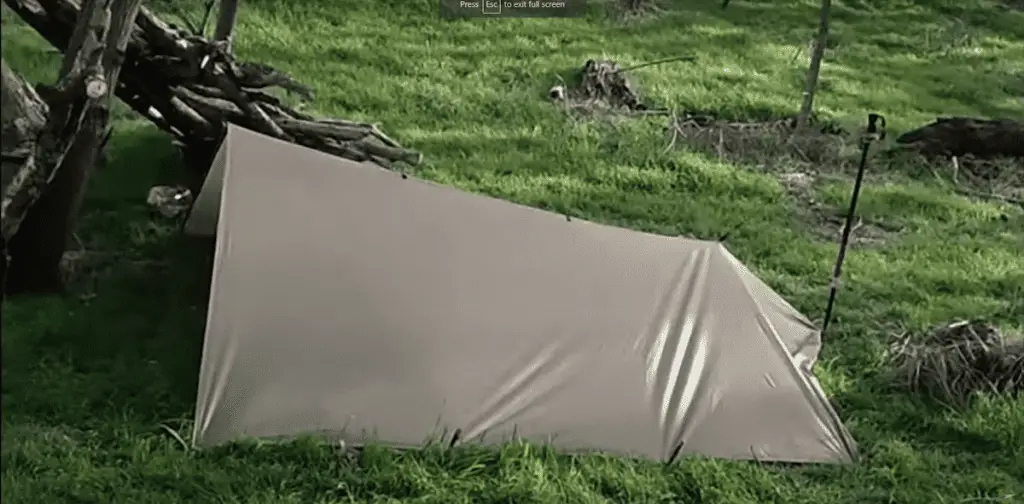
Like all shelters, the Wedge isn’t without its unique considerations. While it does provide good all-around protection, the configuration can be a little more complex to set up than some other designs. Plus, while it can fit two, it might be a tight squeeze if you’re not comfortable getting cozy!
To lay it all out clearly, let’s look at a table of the Wedge Tarp Shelter’s pros and cons.
| Pros | Cons |
|---|---|
| Can accommodate one or two people | Might be a tight fit for two people |
| Provides excellent protection against wind and rain | Configuration can be more complex to set up |
| Good all-around protection | May require more materials to set up properly |
| More space than some other designs | Needs careful planning for efficient setup |
| Ideal for longer stays in one location | Not the quickest design to take down and set up elsewhere |
6. C-Fly Wedge Shelter
When it comes to versatile tarp shelter ideas, the C-Fly Wedge Shelter is definitely one to consider. This unique setup shines in its adaptability, able to shift and adjust according to the weather. Rain or shine, the C-Fly Wedge is ready to take it on.
At its heart, the C-Fly Wedge is a shape-shifter. This shelter can morph to offer more ventilation on warmer, sunnier days or hunker down to provide robust protection during windy or rainy conditions. It’s almost like having a few different shelter types at your fingertips, all rolled into one.
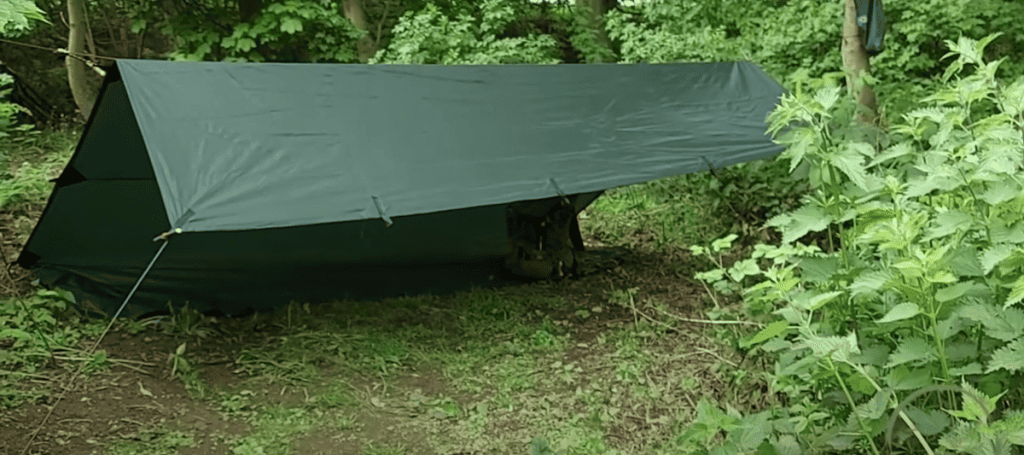
Of course, with such versatility comes a slightly more complex setup. The C-Fly Wedge Shelter may require a bit more time and effort to pitch than simpler designs. However, for those who value adaptability and the ability to respond to changing weather conditions, it’s well worth the investment.
To get a clear overview, let’s lay out the pros and cons of a C-Fly Wedge Shelter.
| Pros | Cons |
|---|---|
| Highly versatile and adjustable | More complex setup than simpler shelters |
| Can be adapted to suit the weather | Might require more materials and time to set up |
| Offers the potential for better ventilation or weather protection as needed | A poor setup could limit its effectiveness |
| Ideal for longer stays in unpredictable weather | Not the quickest design to take down and move |
| Can accommodate one or two people | Not as simple to use for beginners |
7. Tube Tents
When exploring tarp shelter ideas, the Tube Tent is a design worth considering, particularly for those seeking a wrap-around shield from the elements. It’s a simple yet effective structure that offers 360-degree protection – a cocoon of comfort in the wilderness.
Imagine being enveloped in a protective barrier that wards off rain, wind, or snow from any direction. That’s what the Tube Tent delivers. Its design is akin to a tunnel, providing a safe and enclosed space that can offer a sense of security, especially in challenging weather.
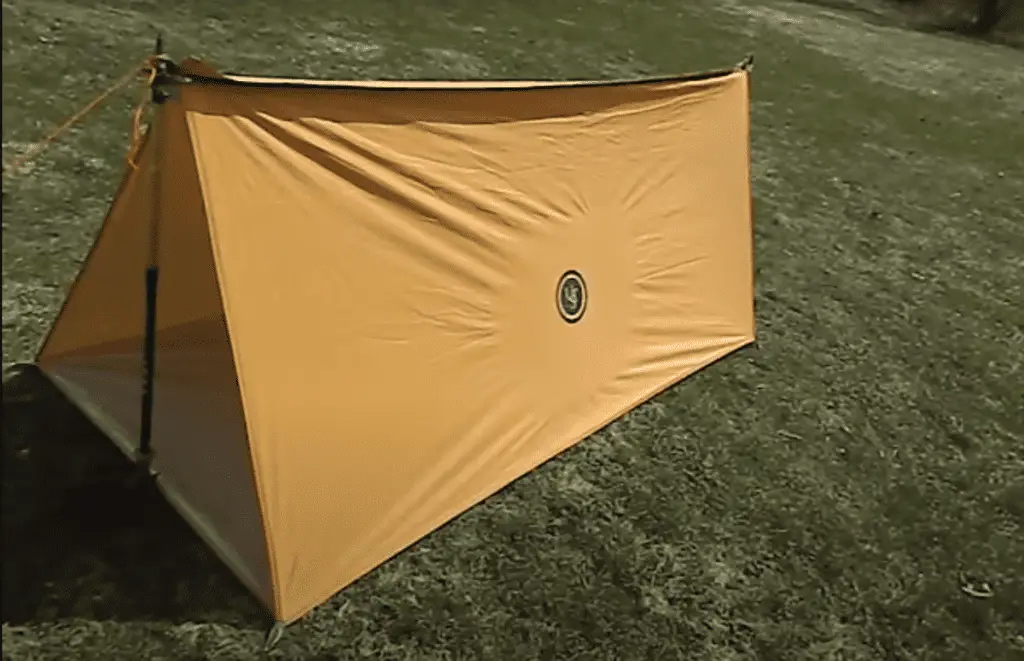
However, every design has its give and take. In the case of the Tube Tent, the trade-off for its all-around protection is less ventilation. While it’ll keep the weather out efficiently, it might also trap heat and moisture in, depending on the weather conditions. It’s a factor to keep in mind when choosing the right shelter for your needs.
To bring it all together, let’s take a look at the pros and cons of the Tube Tent.
| Pros | Cons |
|---|---|
| Offers 360-degree protection | Has less ventilation compared to other designs |
| Simple but effective design | Can trap heat and moisture in certain conditions |
| Provides a sense of security in challenging weather | Not the best option for hot, humid climates |
| Can be set up in various terrain types | Might feel confined for those who prefer open designs |
| Ideal for areas with unpredictable wind direction | The shelter’s stability depends on the strength of the anchor points |
8. Baker Style Shelter
When it comes to tarp shelter ideas that perfectly blend protection and leisure, the Baker Style Shelter is a shining star. This design is a splendid option for camping, offering not just a shield from the elements, but also a charming shaded area where you can relax during the day.
Imagine having a homey corner in the wilderness, where you can unwind under the shade, sipping your coffee while gazing at the scenic views. By night, this very place transforms into a cozy sleeping area, safeguarded against wind and rain. That’s the magic of the Baker Style Shelter.
However, do note that it’s a little more complex to set up compared to some simpler designs. It’s also more suitable for campsites where you intend to stay for a while, rather than quick, one-night stops. Yet, for those who love a balance of comfort and adventure, the Baker Style Shelter could be an ideal fit.
Let’s break it down further with a table illustrating the pros and cons of the Baker Style Shelter.
| Pros | Cons |
|---|---|
| Provides both shelter and shaded area | More complex to set up than simpler designs |
| Great for longer camping trips | Not ideal for quick, one-night stops |
| Can accommodate multiple people | Requires more materials to set up properly |
| Offers a comfortable space to relax during the day | Not as portable as some other designs |
| Excellent for creating a “home base” in a campsite | Might not offer as much protection in extreme weather |
9. Adirondack Wind Shed
When wind is the word, the Adirondack Wind Shed might just top your list of tarp shelter ideas. This design is crafted specifically to tackle windier environments, providing a sturdy windbreak on three sides that stands tall against the gusts.
The Adirondack Wind Shed is essentially your sturdy companion in blustery conditions. With its three-sided design, it’s like being nestled in a protective alcove that shields you from the swirling winds outside. So, whether you’re in a mountain pass or an open plain, this shelter can offer a serene retreat amidst the wild gusts.
However, like any design, the Adirondack Wind Shed has its own set of considerations. While it’s a champ against the wind, its enclosed design might make it less ventilated than other shelters. Plus, it’s more suited for one or two people, so larger groups might need to set up multiple wind sheds.
To bring this into focus, here’s a handy pros and cons table for the Adirondack Wind Shed.
| Pros | Cons |
|---|---|
| Provides a sturdy windbreak on three sides | Less ventilation due to enclosed design |
| Ideal for windier environments | More suited for one or two people |
| Offers good protection against the elements | Can be a bit more complex to set up |
| Can be set up in various terrain types | Might feel confined for those who prefer open designs |
| Provides a sense of security in blustery conditions | Larger groups might need to set up multiple wind sheds |
10. Plow Point Wind Shelter
When speed is the need in your tarp shelter ideas, the Plow Point Shelter is a top contender. This design is all about efficiency, offering a swift setup that gets you shielded from the elements in a flash.
Imagine pulling up to your campsite late, with daylight dwindling. The Plow Point Shelter is your quick-fix refuge in such scenarios. It offers commendable protection, with a design that helps to deflect wind and rain. But remember, it does come with an open side, so it’s essential to position it thoughtfully with respect to the wind direction.
On the flip side, the open side can also be a perk, providing a nice view of your surroundings and easy access in and out of the shelter. But be prepared to adjust your setup if the wind direction changes. All things considered, for its blend of speed and protection, the Plow Point Shelter makes a solid addition to your tarp shelter arsenal.
Let’s crystallize these points with a table summarizing the pros and cons of a Plow Point Shelter.
| Pros | Cons |
|---|---|
| Quick and easy to set up | Open side leaves exposure to elements |
| Offers good protection against wind and rain | Setup direction is crucial for maximum protection |
| Ideal for one person | Might not be suitable for multiple occupants |
| Good for quick, one-night stops | Needs adjustment if wind direction changes |
| Allows for a view of surroundings and easy access | Might require additional windbreaks in windy conditions |
11. The Whelen Lean-To
As we continue to explore tarp shelter ideas, let’s focus on the Whelen Lean-To, a design that takes the simplicity of a lean-to and adds a little extra. This shelter is a more expansive lean-to with wings added on the sides for enhanced protection against wind and rain.
The Whelen Lean-To is a spacious retreat that still manages to maintain a relatively simple setup. It’s like your lean-to has spread its wings, ready to shield you from the elements. It’s a fantastic option for those who need a bit more space, perhaps to store gear or even to house an extra person.
While the Whelen Lean-To brings extra space and protection, it also demands a bit more material and time to set up than its simpler lean-to sibling. However, for those who don’t mind spending a little extra time on setup for the sake of more space and enhanced protection, it’s a great choice.
To lay this out clearly, let’s take a look at a table of the Whelen Lean-To’s pros and cons.
| Pros | Cons |
|---|---|
| Offers more space than a standard lean-to | Requires more material and time to set up |
| Wings on the sides provide extra protection against wind and rain | Not as quick and easy as some other designs |
| Can accommodate more people or gear | Not as lightweight or portable due to the extra material |
| Good for longer stays in one location | Needs careful planning for efficient setup |
| Provides a sense of security in challenging weather | Location choice can greatly affect its efficiency |
12. The Tarp Tipi
When exploring tarp shelter ideas, the Tarp Tipi (or Teepee) Shelter stands out as an impressive blend of tradition and practicality. This design borrows from the wisdom of ancient cultures, delivering excellent all-round protection from the elements in a distinct conical form.
The Tarp Tipi is like your own personal fortress in the wilderness. Its cone shape effectively sheds rain and snow, while its enclosed design helps shield you from the wind from all directions. It can make you feel snug and secure, a much-needed feeling when the weather decides to get rough.
However, the Tarp Tipi isn’t the simplest to construct. It takes a bit more time, effort, and material than some other shelters. But for those willing to embrace the challenge, the payoff is a sturdy, roomy, and weather-resistant shelter that certainly has its own unique charm.
To give a clear overview, let’s lay out the pros and cons of a Tarp Tipi Shelter.
| Pros | Cons |
|---|---|
| Provides excellent all-round protection | More difficult to construct than some other shelters |
| Can accommodate multiple people or gear | Requires more materials to set up |
| Good for longer stays in one location | Not the best option for quick, one-night stops |
| Distinctive and roomy design | Not as portable due to the extra materials required |
| Ideal for challenging weather conditions | Setup location and technique can greatly affect its efficiency |
13. Star Tarp Shelters
As we journey through various tarp shelter ideas, let’s turn our attention to the Star Tarp Shelter. This design is a literal star when it comes to offering full coverage protection, particularly in stormy weather. With multiple anchor points, it creates a secure, enclosed space that can keep you dry and safe.
Imagine being in a dome-like structure that provides 360-degree protection against the elements. That’s the Star Tarp Shelter for you. It’s an excellent option when the weather forecast seems unforgiving, and you need a dependable shield from the storm.
However, due to its design, the Star Tarp Shelter requires more setup time and materials than some other shelters. It’s not the easiest or quickest to erect, but its high level of protection makes it a worthy contender for those willing to invest the time and effort.
To bring it all together, here’s a table outlining the pros and cons of the Star Tarp Shelter.
| Pros | Cons |
|---|---|
| Provides 360-degree protection | More difficult and time-consuming to set up |
| Excellent for stormy weather | Requires more materials to set up |
| Multiple anchor points for stability | Not as lightweight or portable due to the extra materials |
| Can accommodate multiple people | Not the best option for quick, one-night stops |
| Creates a secure, enclosed space | Might be too enclosed for those who prefer open designs |
14. The Pup Tent
While exploring tarp shelter ideas, the Pup Tent presents itself as a little gem in the wilderness. It might be a tad more complex to construct, but the protection it offers from all sides certainly makes it a worthy contender for your consideration.
The Pup Tent is like your personal cabin in the woods. It’s designed to provide a high level of protection, shielding you from wind, rain, and sun from all directions. This makes it a solid choice when you’re setting up camp in less than ideal weather conditions or if you’re staying put for a few days.
However, the trade-off for this protection is a somewhat more intricate setup process. You’ll need to invest a bit more time, effort, and materials compared to simpler designs. Nevertheless, for those who value all-round protection and privacy, the Pup Tent can be an excellent choice.
To help you get a clear picture, here’s a table laying out the pros and cons of the Pup Tent.
| Pros | Cons |
|---|---|
| Provides good protection from all sides | More complex to construct than simpler designs |
| Ideal for less ideal weather conditions | Requires more materials to set up |
| Can accommodate one or two people | Not the quickest option for one-night stops |
| Offers a higher level of privacy | Not as lightweight or portable due to extra materials |
| Suitable for longer stays in one location | Might feel a bit confined for those who prefer open designs |
15. Hammock Tarp Shelter
As we delve further into tarp shelter ideas, the Hammock Tarp Shelter certainly swings into view as a unique and fun option. If you happen to have a camping hammock, you can rig a tarp above it, creating an elevated shelter that lifts you off the ground and into a comfortable night’s sleep.
The Hammock Tarp Shelter is all about combining relaxation with protection. As you swing gently in your hammock, the tarp overhead shields you from the elements, ensuring that rain or dew doesn’t dampen your outdoor experience.
However, it’s important to note that this kind of shelter requires suitable trees or anchor points to set up both the hammock and the tarp, which may limit where you can use it. Also, while it’s an excellent option for fair weather and summer nights, it might not provide enough insulation or protection in colder or more severe weather.
To encapsulate these points, here’s a pros and cons table for the Hammock Tarp Shelter.
| Pros | Cons |
|---|---|
| Elevates you off the ground | Requires suitable trees or anchor points |
| Combines comfort and protection | Might not provide enough insulation in colder weather |
| Good for fair weather and summer nights | Not the best choice for severe weather |
| Can provide a comfortable night’s sleep | Limited to one person per hammock and tarp setup |
| Adds a unique element to your camping experience | Requires a hammock in addition to a tarp |
Concluding Thoughts: Unfolding the Potential of Tarp Shelters
From the traditional A-Frame to the elevated Hammock Tarp Shelter, we’ve traversed an impressive range of tarp shelter ideas, each offering unique advantages and features. These shelter designs underline the versatility and effectiveness of tarps, proving that with a bit of creativity and practical knowledge, they can be transformed into reliable shelters to protect you from the elements.
In conclusion, whether you’re a seasoned outdoors person or just venturing into the wilderness, understanding the different tarp shelter designs can enhance your outdoor experience. Remember, the right shelter for you depends on factors like the weather, your location, the materials at hand, and your personal preference. So, feel free to experiment with these designs, discover your favorites, and have an amazing time exploring the great outdoors!
